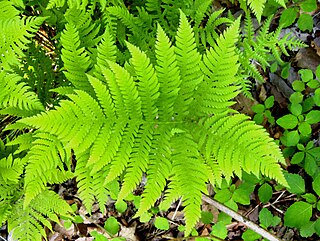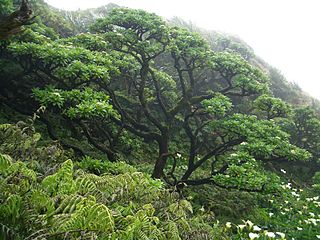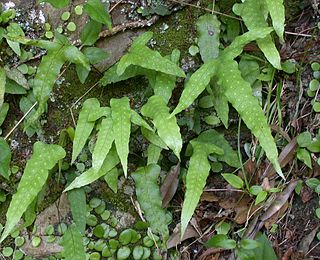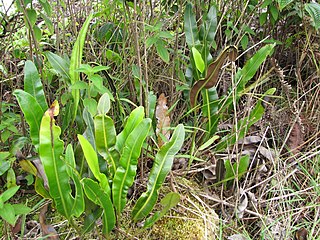
Chives, scientific name Allium schoenoprasum, is a species of flowering plant in the family Amaryllidaceae that produces edible leaves and flowers. Their close relatives include the common onions, garlic, shallot, leek, scallion, and Chinese onion.

Phegopteris is a genus of ferns in the family Thelypteridaceae, subfamily Phegopteridoideae, in the Pteridophyte Phylogeny Group classification of 2016. They are known collectively as the beech ferns. Species are native to Asia, North America and Europe.

Polystichum is a genus of ferns in the family Dryopteridaceae, subfamily Dryopteridoideae, according to the Pteridophyte Phylogeny Group classification of 2016. The genus has about 500 species and has a cosmopolitan distribution. The highest diversity is in eastern Asia, with about 208 species in China alone; the region from Mexico to Brazil has at least 100 additional species; Africa, North America, and Europe have much lower diversity. Polystichum species are terrestrial or rock-dwelling ferns of warm-temperate and montane-tropical regions. They are often found in disturbed habitats such as road cuts, talus slopes, and stream banks.

The Athyriaceae are a family of terrestrial ferns in the order Polypodiales. In the Pteridophyte Phylogeny Group classification of 2016 (PPG I), the family is placed in the suborder Aspleniineae, and includes two genera. Alternatively, it may be treated as the subfamily Athyrioideae of a very broadly defined family Aspleniaceae. The family has with a cosmopolitan distribution.

The flora of Saint Helena, an isolated island in the South Atlantic Ocean, is exceptional in its high level of endemism and the severe threats facing the survival of the flora. In phytogeography, it is in the phytochorion St. Helena and Ascension Region of the African Subkingdom, in the Paleotropical Kingdom.

Antrophyum is a genus of ferns in the family Pteridaceae. They are commonly known as lineleaf ferns.

Palhinhaea cernua, synonym Lycopodiella cernua, is a plant in the family Lycopodiaceae, commonly known as the staghorn clubmoss. The Hawaiian name for the plant is wāwaeʻiole, or "rat's foot". It has a substantial number of scientific synonyms in several genera. The genus Palhinhaea is accepted in the Pteridophyte Phylogeny Group classification of 2016, but not in other classifications which submerge the genus in Lycopodiella.

Selliguea is a fern genus in the family Polypodiaceae. The type species is Selliguea feei.

Dipteris is a genus of about seven species of ferns, native to tropical regions across the world, particularly Asia, with a species in northeastern Queensland in Australia. It is one of two genera in the family Dipteridaceae.
Pronephrium is a genus of ferns in the family Thelypteridaceae in the family Thelypteridaceae, subfamily Thelypteridoideae, in the Pteridophyte Phylogeny Group classification of 2016. Other sources sink Pronephrium into a very broadly defined genus Thelypteris. Some species were split off into the genera Abacopteris, Grypothrix and Menisciopsis in 2021 as a result of a phylogenetic study of the family Thelypteridaceae.

Vandenboschia is a fern genus in the family Hymenophyllaceae. The genus is accepted in the Pteridophyte Phylogeny Group classification of 2016 but not by some other sources.

Elaphoglossum is a genus of ferns in the family Dryopteridaceae, subfamily Elaphoglossoideae, in the Pteridophyte Phylogeny Group classification of 2016.

Gastrolobium nervosum is a small shrub in the pea family (Fabaceae), native to Western Australia.

Polystichum makinoi is a species of fern in the genus Polystichum in the family Dryopteridaceae. It is native to Bhutan, China, India, Japan, Nepal, Tibet, North Korea, South Korea, and Myanmar.
Dryopteris cognata, the large kidney fern, is a herbaceous plant, a member of the Dryopteridaceae family.
Elaphoglossum dimorphum, the toothed tongue-fern, is a herbaceous plant, a member of the Dryopteridaceae family.

Leucadendron nervosum, the silky-ruff conebush, is a flower-bearing shrub that belongs to the genus Leucadendron and forms part of the fynbos. The plant is native to the Western Cape, where it occurs on the Jonaskop in the Riviersonderend Mountains and Grootberg in the Langeberg. The shrub grows 1.5 m tall and flowers in September.
Elaphoglossum hirtum is a species of fern in the Dryopteridaceae family. It is native to some islands in the Caribbean, the Azores and Madeira.













